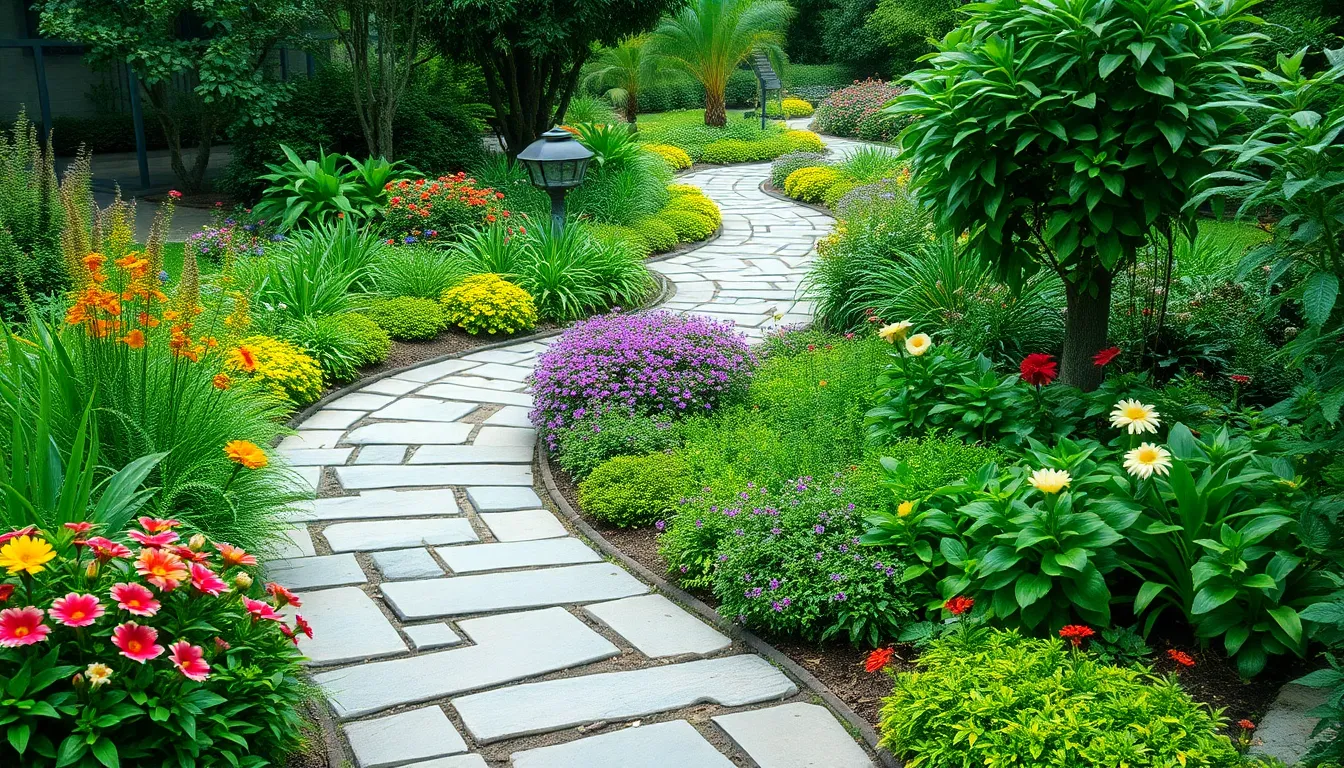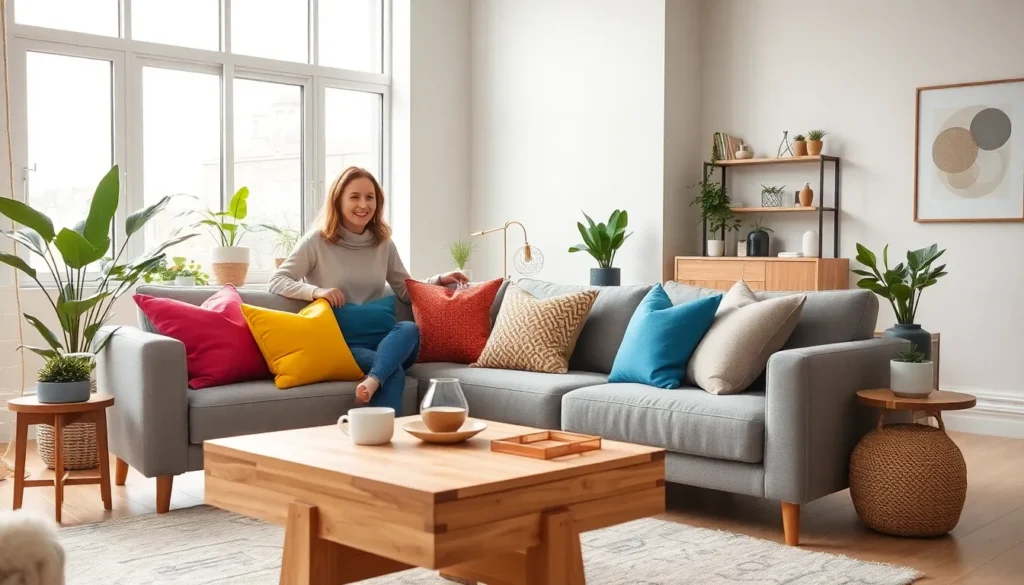When it comes to transforming outdoor spaces, landscape design concepts are the secret sauce that can turn a plain yard into a breathtaking paradise. Imagine sipping your morning coffee surrounded by vibrant flowers, lush greenery, and the soothing sounds of nature. Sounds dreamy, right? But don’t worry—getting there doesn’t require a degree in horticulture or a magic wand.
Table of Contents
ToggleOverview of Landscape Design Concepts
Landscape design concepts encompass various principles and techniques that enhance outdoor spaces. These concepts focus on functionality, aesthetics, and sustainability. Practical elements of design include plant selection, layout, and the integration of hardscaping features like pathways and patios.
A key principle is balance, which ensures that different design elements create harmony. Symmetrical designs offer formal appeal, while asymmetrical designs provide a more relaxed atmosphere. Color schemes play a crucial role; plants with complementary hues can elevate visual interest in gardens.
Another essential concept involves scale and proportion, which refers to the size of elements in relation to each other and the overall landscape. Smaller plants can enhance the scale of larger features, creating depth and dimension. Additionally, texture adds layers; combining various leaf shapes and surface textures enriches the sensory experience.
Sustainability must not be overlooked. Native plants often thrive in local conditions, requiring less maintenance and water. Employing eco-friendly materials also contributes to a healthier environment.
Incorporating these concepts fosters an outdoor space that reflects personal style while being functional and environmentally conscious. Understanding each concept allows for tailored designs that meet specific needs, whether for relaxing, entertaining, or creating wildlife habitats.
Essential Principles of Landscape Design

Achieving a cohesive outdoor space involves understanding key principles in landscape design. These principles guide decisions regarding aesthetics and functionality.
Unity and Harmony
Unity creates a sense of belonging within a landscape. Elements like color, texture, and shape should complement one another, forming a cohesive visual narrative. Plant selection plays a crucial role in establishing this continuity. Choosing species that share similar colors or growing habits fosters a harmonious environment. Pathways and hardscaping can enhance unity by connecting different areas with consistent materials or patterns. Every component of a landscape should work together to create a seamless experience, inviting users to explore the space.
Balance and Proportion
Balance and proportion are essential for visually appealing landscapes. Achieving balance involves distributing elements evenly across the space, ensuring that no area appears too heavy or cluttered. Symmetrical arrangements lend a formal touch, while asymmetrical designs promote a relaxed vibe. Additionally, proportion refers to the size relationship between elements, such as plants, structures, and open areas. Proper scale enhances the overall visual impact, allowing larger features to coexist with smaller ones without overwhelming the design. Emphasizing these principles ensures a well-composed outdoor setting that captivates and engages onlookers.
Types of Landscape Design Concepts
Various landscape design concepts each offer unique ways to enhance outdoor environments. Understanding these types can help in creating personalized spaces.
Formal Design
Formal design emphasizes symmetry and structured layouts. It often features geometric shapes and clearly defined lines. This approach creates a sense of order, making spaces appear balanced. Focal points such as sculptures or hedges play a crucial role in guiding the eye. Flower beds follow specific shapes, appearing orderly and intentional. Paths may incorporate straight lines, shaping a formal narrative throughout the landscape. Formal design often suits traditional homes and gardens, enhancing their architectural features.
Informal Design
Informal design embraces a relaxed, organic approach. Natural curves and asymmetry dominate the layout. This type features a more casual arrangement of plants, blending colors and textures harmoniously. Pathways often meander through the landscape, inviting exploration. Plants are grouped in a more natural manner, creating a lush, inviting feel. Informal design promotes a comfortable atmosphere, often suitable for contemporary residences and gardens. These spaces encourage interaction, fostering a connection with nature.
Xeriscaping
Xeriscaping focuses on water conservation while enhancing visual appeal. This method uses drought-resistant plants, often native to the region, minimizing water usage. Soil preparation plays a vital role in this type of design, ensuring proper drainage. Additionally, strategically placed mulch can reduce evaporation. A variety of textures and colors still exist, providing an aesthetic landscape despite lower water needs. Xeriscaping supports sustainable practices while creating vibrant outdoor spaces. Ultimately, it reflects a commitment to environmental responsibility.
Elements of Landscape Design
Various elements contribute to effective landscape design. Attention to plant selection and hardscape features creates a harmonious outdoor environment.
Plants and Vegetation
Selecting diverse plants enhances visual interest and supports local biodiversity. Native species thrive in local conditions, requiring less maintenance and water. Incorporating a mix of trees, shrubs, and flowers adds layers and textures, creating depth in the design. Seasonal variations can produce changing colors and fragrances over the year. Groups of plants can establish focal points, drawing the eye and inviting exploration.
Hardscape Features
Hardscape elements like paths, patios, and walls provide structure and functionality. Materials such as stone, wood, and concrete can create inviting spaces for gathering or relaxation. Pathways guide users through the landscape, improving accessibility and flow. Decorative walls can delineate areas, adding privacy or creating visual boundaries. Incorporating features like pergolas or trellises enhances vertical interest while providing shade and support for climbing plants.
Importance of Sustainable Landscape Design
Sustainable landscape design significantly influences environmental health. Incorporating native plants supports local ecosystems, reducing the need for chemical fertilizers and pesticides. Such choices promote biodiversity and attract beneficial wildlife, enriching outdoor spaces.
Water conservation is essential in sustainable design practices. Implementing xeriscaping techniques minimizes water usage while ensuring beautiful aesthetics. Drought-resistant plants require less irrigation, making landscapes more resilient in changing climates.
Utilizing eco-friendly materials enhances sustainability in hardscaping features. Materials like permeable pavers allow for better water drainage and reduce stormwater runoff. These choices contribute to healthier soil and local water quality.
Energy efficiency plays a crucial role in landscape sustainability. Strategically placed trees provide shade, reducing energy consumption for heating and cooling. A well-planned design decreases the urban heat island effect, creating a cooler environment for communities.
Creating outdoor spaces with a focus on human health fosters relaxation and well-being. Incorporating recreational areas, such as gardens and seating spaces, invites social interaction. Spaces designed for enjoyment promote mental health and encourage physical activity.
Incorporating sustainability within landscape design aligns with global conservation efforts. It encourages responsible management of resources while meeting the needs of current and future generations. Committing to sustainable practices not only benefits the environment but also enhances the aesthetic appeal and functionality of outdoor spaces.
Embracing landscape design concepts can significantly elevate outdoor spaces into stunning environments. By focusing on functionality and aesthetics while prioritizing sustainability, individuals can create personalized areas that reflect their unique style. Integrating native plants and eco-friendly materials not only enhances visual appeal but also supports local ecosystems and promotes environmental health.
Whether opting for formal symmetry or a more relaxed informal design, the principles of unity and balance ensure a cohesive visual narrative. Ultimately, thoughtful landscape design enriches lives by fostering relaxation and encouraging social interaction, making outdoor spaces more enjoyable for everyone.









